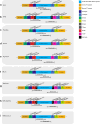A standardized framework for robust fragmentomic feature extraction from cell-free DNA sequencing data
- PMID: 40410787
- PMCID: PMC12100915
- DOI: 10.1186/s13059-025-03607-5
A standardized framework for robust fragmentomic feature extraction from cell-free DNA sequencing data
Abstract
Fragmentomics features of cell-free DNA represent promising non-invasive biomarkers for cancer diagnosis. A lack of systematic evaluation of biases in feature quantification hinders the adoption of such applications. We compare features derived from whole-genome sequencing of ten healthy donors using nine library kits and ten data-processing routes and validated in 1182 plasma samples from published studies. Our results clarify the variations from library preparation and feature quantification methods. We design the Trim Align Pipeline and cfDNAPro R package as unified interfaces for data pre-processing, feature extraction, and visualization to standardize multi-modal feature engineering and integration for machine learning.
Keywords: Cancer genomics; CfDNA; Feature extraction; Fragmentomics.
© 2025. The Author(s).
Conflict of interest statement
Declarations. Ethics approval and consent to participate: This study uses commercially available plasma samples of human origin; the respective guidelines have been followed (IRB Tracking Number: 20161665). The experiments conformed to the principles set out in the WMA Declaration of Helsinki and the Department of Health and Human Services Belmont Report. Consent for publication: Not applicable. Competing interests: CGS is currently a member of Neogenomics, and FM is a co-founder and director of Tailor Bio. Neogenomics and Tailor Bio had no role in the conceptualisation and design of the study, statistical analysis, or decision to publish the manuscript.
Figures







References
-
- Wan JCM, Massie C, Garcia-Corbacho J, Mouliere F, Brenton JD, Caldas C, et al. Liquid biopsies come of age: towards implementation of circulating tumour DNA. Nat Rev Cancer. 2017;17:223. - PubMed
-
- Dennis Lo YM, Corbetta N, Chamberlain PF, Rai V, Sargent IL, Redman CWG, et al. Presence of fetal DNA in maternal plasma and serum. Lancet. 1997;350:485-7. - PubMed
MeSH terms
Substances
Grants and funding
- FP/2007-2013/European Research Council under the European Union's Seventh Framework Programme
- FP/2007-2013/European Research Council under the European Union's Seventh Framework Programme
- FP/2007-2013/European Research Council under the European Union's Seventh Framework Programme
- G101107/CRUK_/Cancer Research UK/United Kingdom
- C36857/A27548/CRUK_/Cancer Research UK/United Kingdom
- C36857/A27548/CRUK_/Cancer Research UK/United Kingdom
- C1287/A26886/CRUK_/Cancer Research UK/United Kingdom
- C1287/A26886/CRUK_/Cancer Research UK/United Kingdom
- C36857/A27548/CRUK_/Cancer Research UK/United Kingdom
- G101107/CRUK_/Cancer Research UK/United Kingdom
- C36857/A27548/CRUK_/Cancer Research UK/United Kingdom
- C64667/A27958/Joint Royal College of Surgeons & Cancer Research UK
- C64667/A27958/Joint Royal College of Surgeons & Cancer Research UK
- C64667/A27958/Joint Royal College of Surgeons & Cancer Research UK
- C7893/A26233 and CTRQQR-2021\100004/infrastructure grants within the CRUK City of London Major Centre Awards
LinkOut - more resources
Full Text Sources

